

Man creates 'invisible headphones' by implanting magnets into his ears. The Cyborg Foundation: we urge you to become part-machine. Moon Ribas and Neil Harbisson from The Cyborg Foundation urged the audience at Pioneers Festival to consider experimenting with cyborgism.
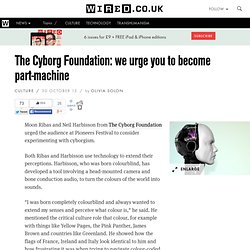
Why Teenagers Act Crazy. Photo is practically synonymous in our culture with risk taking, emotional drama and all forms of outlandish behavior.
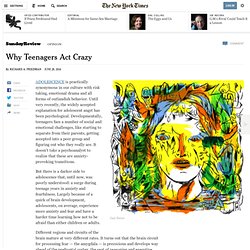
Until very recently, the widely accepted explanation for adolescent angst has been psychological. 'Godfather of ecstasy' Sasha Shulgin who introduced MDMA dies at 88. Gamma Wave Brain Zaps Induce Lucid Dreaming — NOVA Next. Some people have as much fun in their dreams as they do in real life.

While sleeping, they might change the direction of their dream’s storyline, fly to remote places, explore untrodden territory, or encounter strange creatures. They’re like film directors, guiding the artistic vision of their subconscious. Lucid dreamers are aware that they're dreaming—which means it's possible for them to influence which path the dream's story will take. Such creative license is thanks to a state of mind called lucid dreaming.
Two New Letters for the DNA Alphabet. Scientists keep getting better at rewriting the book of life.
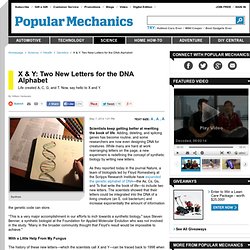
Adding, deleting, and splicing genes has become routine, and some researchers are now even designing DNA for creatures. While many are hard at work rearranging letters on the page, a new experiment is redefining the concept of synthetic biology by writing new letters. As they reported today in the journal Nature, a team of biologists led by Floyd Romesberg at the Scripps Research Institute have expanded the genetic alphabet of DNA—the As, Cs, Gs, and Ts that write the book of life—to include two new letters.
The scientists showed that their letters could be integrated into the DNA of a living creature (an E. coli bacterium) and increase exponentially the amount of information the genetic code can store. “This is a very major accomplishment in our efforts to inch towards a synthetic biology," says Steven Benner, a synthetic biologist at the Foundation for Applied Molecular Evolution who was not involved in the study. Biohackers: A journey into cyborg America. TEDxWarwick - Kevin Warwick - Implants & Technology. NOVA scienceNOW w/ Neil deGrasse Tyson: Can we live forever? Cybernetic living plant with flowers.
Korean artist Choe U-Ram masterful art of making electrical installations of great beauty.

Cybernetic living plant with flowers. Cybernetic living plant with flowers. IMPAKT – critical and creative views on contemporary media culture. Report Impakt Event: Deep Fake or Rendering the TruthReport of Impakt Event: Deep Fake or Rendering the Truth on April 21st 2018 with video and pictures Impakt Event: Judging the MachineOver the past few years, artificial intelligence has become a constant presence in our lives, recommending news articles, recognising faces and providing customer support.

Machine […] Impakt Event: Algorithmic SuperstructuresAlgorithmic Superstructures, a presentation by the curators of Impakt Festival 2018 In the age of post-truth, algorithmic superstructures are looking over your shoulder. Predictive analysis, […] Impakt Event: Post-truth Cinema – The Cleaners + Eva de ValkFrom May until December Impakt will organise the film series Post-truth Cinema in collaboration with Cinema ‘t Hoogt. By means of documentaries and feature films the […] Harvard discovers three of its library books are bound in human flesh. There's something undeniably creepy about big, expansive libraries. The hushed whispers, the almost artificial quiet, and the smell of dusty tomes combine to create a surreal experience.
But when it comes to creepy libraries, Harvard University might take the cake... you see, at least two of its books are bound in human skin. A few years ago, three separate books were discovered in Harvard University's library that had particularly strange-looking leather covers. A New, Reversible, Cause of Aging. Mitochondria, organelles on the right, interact with the cell's nucleus to ensure a healthy, functioning cell.

Image by Ana GomesResearchers have discovered a cause of aging in mammals that may be reversible. The essence of this finding is a series of molecular events that enable communication inside cells between the nucleus and mitochondria. As communication breaks down, aging accelerates. By administering a molecule naturally produced by the human body, scientists restored the communication network in older mice. Subsequent tissue samples showed key biological hallmarks that were comparable to those of much younger animals. “The aging process we discovered is like a married couple—when they are young, they communicate well, but over time, living in close quarters for many years, communication breaks down,” said Harvard Medical School Professor of Genetics David Sinclair, senior author on the study.
The findings are published Dec. 19 in Cell. New Research Could Lead to 3D Mugshots Based on DNA. Why Synthetic Biology Is the Field of the Future — NOVA Next. Most Americans may not be familiar with synthetic biology, but they may come to appreciate its advances someday soon.

Synthetic biology focuses on creating technologies for designing and building biological organisms. A multidisciplinary effort, it calls biologists, engineers, software developers, and others to collaborate on finding ways to understand how genetic parts work together, and then to combine them to produce useful applications. Synthetic biology is a relatively young field, begun only about ten years ago. Legal Heroin: Is Virtual Reality Our Next Hard Drug?
So video games are addictive—this we know.
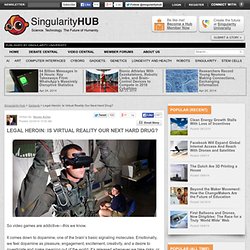
It comes down to dopamine, one of the brain’s basic signaling molecules. Emotionally, we feel dopamine as pleasure, engagement, excitement, creativity, and a desire to investigate and make meaning out of the world. BioScapes Photo Competition Winners Prove Sometimes Nature Is The Best Artist. Open trap of aquatic carnivorous plant, humped bladderwort Utricularia gibba, with single-cell organisms inside.
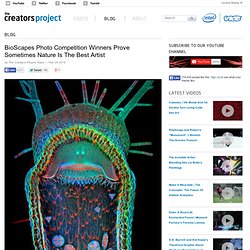
Technique: Confocal imaging, 100x. Shot by Dr. Single Chip Device to Provide Real-Time 3-D Images from Inside the Heart, Blood Vessels. A single-chip catheter-based device that would provide forward-looking, real-time, three-dimensional imaging from inside the heart, coronary arteries and peripheral blood vessels is shown on the tip of a finger. Image: Georgia Tech Photo: Rob Felt Atlanta, GA (Scicasts) – Researchers have developed the technology for a catheter-based device that would provide forward-looking, real-time, three-dimensional imaging from inside the heart, coronary arteries and peripheral blood vessels. With its volumetric imaging, the new device could better guide surgeons working in the heart, and potentially allow more of patients' clogged arteries to be cleared without major surgery.
The device integrates ultrasound transducers with processing electronics on a single 1.4 millimetre silicon chip. Using photosynthesis to generate fresh water. Annegret Honsbein is a post-doc in Anna Amtmann‘s lab at the University of Glasgow. As she explains in this guest post, she is working on an EPSRC project that hopes to harness the power of photosynthesis to desalinate sea water. Citizen science draws amateurs into scientific research. For thousands of ordinary people around the world, one of biology’s hardest problems is just a game. Both scientists and supercomputers have long struggled to predict the three-dimensional structures of the biological molecules called proteins. These structures are crucial to understanding proteins’ roles in fundamental cellular processes and disease, but predicting them is no easy task—which is why some researchers have turned to laypeople for help.
In theory, a protein’s structure should be calculable from the molecule’s underlying chemistry: from its initial state as a linear chain of chemical building blocks called amino acids, each protein is thought to fold into its most stable possible configuration. But there are infinite structural possibilities for any given amino-acid chain, and a computer, searching through them, faces a daunting challenge. Sneaky molecules unzip when they locate disease. "These types of switchable nanoparticles could be extremely versatile. As well as initial detection of a medical condition, they could be used to monitor the progress of diseases and courses of treatment, or adapted to deliver potent drugs at particular locations in a patient's body," says Cameron Alexander. (Credit: University of Nottingham) Scientists are testing encapsulated molecules that unzip and spring into action when triggered to do so. A sheath of biocompatible polymer shrouds the biologically active material inside, preventing any interaction so long as the shield remains in place.
The smart aspect is in the DNA-based zippers that hold the coat in place. What is then exposed—an active pharmaceutical compound, a molecular tag to attach to diseased tissue, or a molecular beacon to signal activation—depends on what function is needed. New discovery about maple sap could revolutionize syrup industry. Synthetic Life Created by Synthetic Genomics - Nanalyze. In an earlier article we discussed the exciting potential of synthetic biology, a market that according the to UK government will grow from $1.8 billion in 2011 to $11.8 billion by 2016. One pioneer in the field of synthetic biology is American biologist and entrepreneur, Craig Venter. In 2010, Mr. 5 Unbelievable (but Real) Technologies Made Possible by Synthetic Biology (AMRS, SZYM, XON) Synthetic biology, or breaking down life into its basic component parts to create enhanced biological systems, can be likened to writing software that enables life.
Or genetic engineering on steroids. Fisherman plucks bizarre shrimp-like creature from the water off New Zealand that's completely see-through. Engineers Develop Tiny Swimming Bio-Bots. Engineers developed the first tiny, synthetic machines that can swim by themselves, powered by beating heart cells. Image: Photo by Alex Jerez Roman, Beckman Institute for Advanced Science and Technology. With Emotion Recognition Algorithms, Computers Know What You’re Thinking.
New Online Magazine Bridges the Divide Between Art and Science. Weekend Diversion: Spider Webs… on drugs? The Living Factory: Designing and Manufacturing with Synthetic Biology. Synthetic biology and the rise of the 'spider-goats' Anti-ageing compound set for human trials after turning clock back for mice. Why Some People Respond to Stress by Falling Asleep - Elijah Wolfson. Hackerspaces are becoming the center of liberal arts in Asia: NUS prof. Why anti-vaxxers might be creating a world of super viruses. Dolphin teens get high by chewing pufferfish. This clear purple sea creature is proof the ocean is where aliens hide. The Dramatic Differences in Male and Female Brain Connectivity. In mice, fear learned by parents is transferred to their offspring. David Nutt's new drug mimics alcohol … minus the health risks and hangovers. Scientists Build Programmable Glue from DNA. 4 Things You’ll Feel Right Before a Heart Attack.
Synthetic Biology to the Next Stage. Synthetic endocannabinoid activation may be the anxiety cure of the future - Birmingham science news. 3D Printed Human Organ Models Help Surgeons Prepare. NASA Awards Project for 3D Bioprinting Anything You Want. Kickstarter bans project creators from giving away genetically-modified organisms. Awesome Photo of an Orange-Slice Battery. The biological microprocessor, or how to build a computer with biological parts. Scientists to build a chromosome for the world's first synthetic yeast. SynBrick: A crowdsourcing game for Synthetic Biology. We shape our world. #A.I.L - artists in laboratories, episode 32: Patrick Stevenson-Keating. Project Cyborg - Projects. Advanced Paper Could Be Foundation for Inexpensive Biomedical and Diagnostic Devices. #A.I.L - artists in laboratories, episode 28 (the London Hackspace) Why Your Next Phone Will Include Fingerprint, Facial, And Voice Recognition. A Documentary Film about Synthetic Biology by Field Test Film Corps.
OpenPCR - the $599 Personal PCR Machine / Thermal Cycler. Scientists Develop New system to Improve DNA Sequencing. Bioglass Helping to Mend Bones. A Circadian Clock-Regulated Toggle Switch Explains AtGRP7 and AtGRP8 Oscillations in Arabidopsis thaliana. BioArt Laboratories. Nanotechnology set to revolutionize smart grid evolution.
Making living matter programmable. Fingerprints Instead Of Credit Cards? YC-Backed PayTango Aims To Make Payments Work Through Biometrics. Building-in Biosafety for Synthetic Biology. [Microbiology. 2013. REALLY GOOD STUFF. Why Synthetic Biology Is the Field of the Future — NOVA Next. Weird Science: Biotechnology as Art Form.
Neuristors and the future of brain-like computing. Main Page. Tools for the Synthetic Biology Revolution. Update on Synthetic Biology. 8 Projects Bringing Synthetic Biology to Your Doorstep (AMRS, CDXS, SZYM) Fluorescent Proteins and in Vitro Genetic Organization for Cell-Free Synthetic Biology - ACS Synthetic Biology. How to Stop Chinese Copycats from Stealing Your App. Great Balls of Fire! Make Your Own Chemistry Lab… Synthetic Biology: Drew Endy. Welcome to Genspace. About. Institute News.
Consensus: “Can tDCS and TMS enhance motor learning and memory formation?” Office of the CIO. Zap your brain into the zone: Fast track to pure focus - life - 06 February 2012. NeuroImage - TDCS guided using fMRI significantly accelerates learning to identify concealed objects. Amping Up Brain Function: Transcranial Stimulation Shows Promise in Speeding Up Learning.
Deus Ex: The Eyeborg Documentary. Why DIY Brain Stimulation Is a Really Dumb Idea. NEWS FROM THE FUTURE – Transcranial direct current stimulation (tDCS) kits. DIY Kit Overclocks Your Brain With Direct Current. GoFlow: a DIY tDCS brain-boosting kit. GoFlow - World's First tDCS Kit.